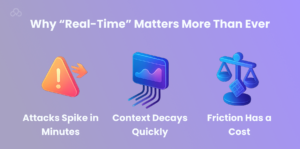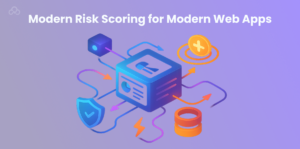Static rules used to work. Then traffic got weird, rotating IPs, disposable devices, botnets that morph mid-session. If your controls still fire once per login or once per night, you’re chasing yesterday’s attack with today’s customers. Real-time risk scoring fixes that. It turns the stream of signals you already collect into a rolling judgement: how risky is this request, this session, this action, right now? Done well, it calms web app security, sharpens threat detection, and keeps good users moving with minimal friction.
What Risk Scoring Is
Risk scoring is an always-on layer that fuses network, device, behavior, identity, and payment signals into a single, interpretable score. It’s dynamic risk assessment by design; the score updates as context changes. Pass WebAuthn? Risk drops. Ten rapid card attempts from a fresh device? Risk jumps. It’s the decision engine behind modern fraud scoring systems, telling your app when to allow, when to step up, when to throttle, and when to block outright.
It’s not a replacement for common-sense controls. Blacklists, rate limits, and content validation still matter. Risk scoring makes them adaptive and consistent across your stack.
Why “real-time” matters more than ever

1. Attacks spike in minutes, not days. Card testing, credential stuffing, and inventory scalping ramp fast; batch jobs are already late.
2. Context decays quickly. A device that looked fine five minutes ago may now be farming gift cards. Risk scoring captures that flip.
3. Friction has a cost. Adaptive controls add just-enough friction only to higher-risk cohorts, preserving conversion and trust, core to web app security and revenue.
Short example: A user lands from hotel Wi-Fi. Score rises. They pass passkey authentication; score falls. They immediately add two new cards and probe your pricing API 200 times. Score spikes. The policy flips to step-up plus rate-limit. No heroics. Just steady threat detection in motion.
Signals That Actually Move The Needle
Not all signals are equal. Prioritise the ones that consistently add lift in fraud scoring systems:
High-Value Risk Signals (IP/Network), Practical Actions for Threat Detection
|
Signal (IP/Network) |
Why it matters |
Confidence trend |
Recommended action |
|
TOR / anonymiser / residential proxy |
Routes a lot of automated abuse |
High → decays slowly |
Challenge sensitive flows; heavier rate limits |
|
Datacenter ASN on consumer path |
Bot infra posing as “users” |
Medium |
Block high-risk routes; allow read-only |
|
IP freshness / newborn subnet |
Common in hit-and-run |
Medium → decays fast |
Step-up on payment; relax after cool-down |
|
Local abuse history (your site) |
Proven bad here |
Very high |
Hard block or tarpit; long decay |
Device & Behavior Risk Signals, Actions for Dynamic Risk Assessment
|
Signal (Device/Behavior) |
Why it matters |
Confidence trend |
Recommended action |
|
Device fingerprint reuse across accounts |
Account farming |
High |
Step-up + throttle create/confirm |
|
Emulator/root/JB hints |
Automation risk |
Medium |
Challenge; restrict risky API writes |
|
Behavioral oddities (typing/pointer cadence) |
Bot tells |
Medium |
Challenge; monitor abandonment |
|
Velocity spikes across routes |
Orchestrated testing |
High during burst |
Progressive rate-limit; deny on repeat |
Keep hard signals (your own abuse history, confirmed TOR) close to deterministic. Treat softer ones (newborn subnet) as nudges that raise the bar but don’t auto-block.
Architecture you can actually ship
A pattern your platform or Custom Web Development Services partner can implement without blowing up latency:
1. Event stream at the edge. Every meaningful action emits a compact event (user/session IDs, IP/ASN, device ID, route, amount).
2. Feature service. Maintains rolling windows (per device, per account) to compute features like velocity, reuse, cohort z-scores.
3. Scoring layer. Small, fast model plus guardrail rules. Deterministic checks catch obvious issues; the model handles nuance.
4. Policy engine. Maps score bands to actions (allow, step-up, throttle, block, manual review). Keep the mapping in config so security can adjust without redeploy.
5. Feedback loop. Confirmed frauds, chargebacks, successful MFAs, and appeals flow back to retrain features and refresh weights.
6. Observability. Dashboards for latency (p50/p95), decision mix, false positives on loyal cohorts, and lift versus baseline.
Scoring logic (plain-English, no formulas)
Combine weighted signals into a score between 0 and 100, then map bands to decisions:
1. 0–29 (Low): Allow and log.
2. 30–59 (Medium): Allow on most routes; show gentle verification on sensitive actions.
3. 60–79 (High): Step-up authentication (WebAuthn/OTP) and apply light throttling on risky endpoints.
4. 80–100 (Critical): Block, or require manual review for high-value operations.
Tune bands per route, login, checkout, password reset, so web app security and conversion both win. Add band decay so scores drop quickly when users behave normally; no one should be stuck in a penalty box longer than necessary.
Actions that de-risk without wrecking UX
– Step-up only when needed. Passkeys/WebAuthn for high band sessions; let low-risk users glide.
– Progressive throttling. Start gentle; escalate on persistence. Great for scrapers and token testers.
– Soft blocks and tarpits. Waste bot time; keep real users moving.
– Hard blocks. Save for high-confidence abuse (deny-listed device + proxy + velocity spike).
– Consistent decisions across microservices. Share score and action via headers or a central service so downstream systems don’t contradict each other.
Case snapshots (short and concrete)
1. Marketplace account takeover. Real-time risk scoring on login plus device reuse features cut credential-stuffing success by double digits. Step-ups touched ~2% of users; help-desk tickets stayed flat.
2. E-commerce card testing. BIN risk + IP freshness + cross-card device reuse flagged sequences early; chargeback rate trended down the next cycle.
3. B2B SaaS API abuse. Datacenter ASNs hitting write endpoints triggered staged throttles; pinned partner IPs sailed through. Clean threat detection, no fire drills.
What to Measure
Latency & reliability
– Scoring latency (median/p95), feature compute time, decision cache hit-rate.
Effectiveness
– Attack success rate (ATO, card testing), challenge pass rate, chargebacks by cohort, manual review load and turnaround.
Business health
– Conversion uplift on low-risk cohorts, abandonment delta on challenged sessions, refund/appeal outcomes.
Model health
– Calibration (“does a 70 feel like a 70 this week?”), drift in top features, stability of bands over time.
Build, buy, or blend?
1. Buy commodity inputs: IP reputation, device intelligence, and some payment risk data.
2. Build the glue: feature service, policy engine, feedback loop specific to your domain.
3. Blend for speed: let vendors power inputs while your team owns dynamic risk assessment policy. If capacity is thin, lean on Custom Web Development Services to harden the integration, automation, and on-call.
Technical FAQs
1) Which model types work best for real-time risk scoring?
Start with gradient-boosted trees or similarly fast tabular models. They’re quick, interpretable, and strong on sparse fraud data. Layer simple rules for “hard constraints” (deny-listed device ⇒ block). Deep models can help at scale, but only if labels are clean and latency budgets hold.
2) How do we set thresholds without crushing conversion?
Run in shadow mode for two to three weeks. Compare suggested decisions to outcomes (fraud confirmed, MFA passed, chargeback, abandonment). Start conservative, A/B small band adjustments, and watch three numbers: conversion, challenge pass rate, and attack success rate. Tighten friction only where lift is clear.
3) Can we rely on third-party signals for threat detection?
Use them, never alone. External feeds (IP reputation, device intel) drift; first-party signals (account age, prior disputes, session patterns) keep the model honest. Retrain regularly, and retire features that stop adding lift.
4) Where should risk scoring live, edge, app, or both?
Both. Edge for coarse, fast controls. App tier for context-rich decisions (history, payments, permissions). Share the score centrally so microservices respond consistently.
5) How do we reduce bias in fraud scoring systems?
Audit features for proxies to protected classes, compare false-positive rates by cohort, and calibrate bands separately if needed. Document policy exceptions and keep a transparent appeals process. Bias wastes revenue and trust.
6) What’s a safe rollback plan if the model misbehaves?
Version-pin models and rules. Keep last-known-good ready. Add kill switches per route (login/checkout/reset). If precision drops below your floor or latency spikes, roll back instantly and root-cause offline.
Modern Risk Scoring for Modern Web Apps

Real-time risk scoring turns scattered hints into one steady decision, every request, every step. It strengthens web app security, powers threat detection, and lets fraud scoring systems add friction precisely where it pays off. Start small, measure hard, and iterate with product, security, and Custom Web Development Services in the loop. Less guesswork. More control.
Do you like to read more educational content? Read our blogs at Cloudastra Technologies or contact us for business enquiry at Cloudastra Contact Us.